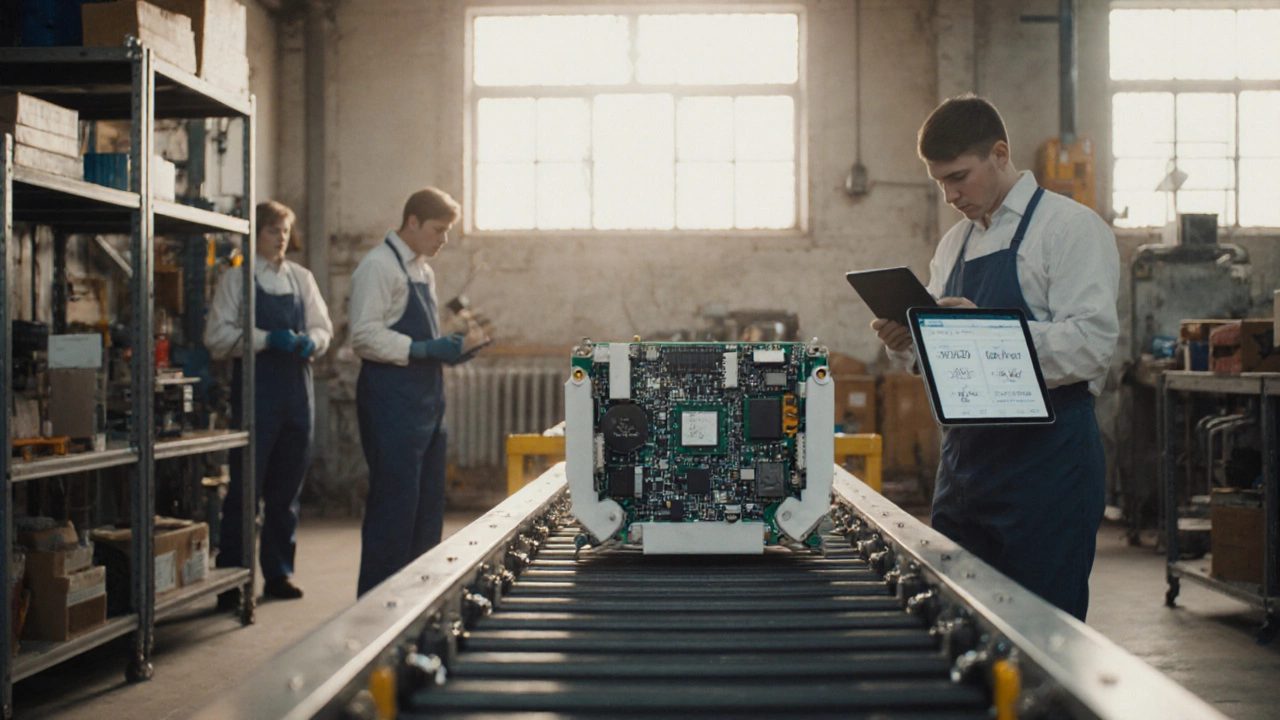Manufacturing Flows Assessment Tool
How well are your manufacturing flows working?
Answer these 7 questions about your production process. If you answer "No" to 3 or more, one or more flows are broken.
1. Material Flow
Can you trace a single order from raw material to delivery without asking three people?
2. Information Flow
Do your operators know what to do next without checking a paper list?
3. Energy Flow
Is your energy bill rising faster than your output?
4. Financial Flow
Do you know the true cost to make one product?
5. Human Flow
Can any worker stop the line if something's wrong?
6. Quality Flow
Have you implemented at least one employee suggestion in the last 30 days?
7. Improvement Flow
Are you still using paper work orders?
Your Manufacturing Flows Assessment
Most factory managers don’t realize their shop floor is broken-not because of bad machines, but because they’re missing one of the seven flows of manufacturing. If your production is slow, inventory piles up, or orders get mixed up, the problem isn’t your workers. It’s that one or more of these flows aren’t working right.
What Are the Seven Flows of Manufacturing?
The seven flows are the invisible pathways that keep a factory alive. They’re not just steps in a process-they’re the actual movement of things, data, and people that turn raw materials into finished products. Think of them like blood vessels in a body. If one stops working, everything else suffers.
These flows were first clearly defined by lean manufacturing experts in the 1980s, based on decades of observation in Japanese factories. Today, they’re used everywhere-from small workshops in Bristol to massive automotive plants in Germany. If you run any kind of manufacturing operation, you need to understand and manage all seven.
1. Material Flow
This is the most obvious one. It’s the physical movement of raw materials, parts, and finished goods through your facility. But here’s the catch: material flow isn’t just about moving stuff. It’s about moving the right stuff, at the right time, to the right place.
Many factories still use big batch production-making 500 units of one part before switching to another. That creates huge piles of inventory, takes up floor space, and hides defects. Lean manufacturers use small batches or even single-piece flow. One part moves from station to station, with no waiting. That cuts lead time by 60-80% in most cases.
Example: A small electronics assembler in Wales switched from weekly batch runs to continuous flow. Their work-in-progress inventory dropped from 1,200 units to 80. Delivery times went from 14 days to 3.
2. Information Flow
This is where most factories fail silently. Information flow is how orders, schedules, quality specs, and machine settings move from planning to production to shipping.
If your shop floor still uses paper work orders, whiteboards, or Excel sheets passed between departments, you’re fighting a losing battle. Information gets lost, delayed, or misinterpreted. A single typo in a BOM (Bill of Materials) can shut down a line for hours.
Modern factories use digital work instructions, ERP systems, and real-time dashboards. A machine operator in a Birmingham tool shop now sees exactly which part to make, what torque to use, and which QC check to run-all on a tablet. No more hunting for printouts.
3. Energy Flow
Energy isn’t just electricity. It’s compressed air, steam, hydraulic pressure, and even heat from machines. If your energy flow is inefficient, you’re throwing money away.
One textile manufacturer in Leicester found that 40% of their electricity was wasted on idle compressors running 24/7. They installed smart sensors that turned off air compressors when no machines were active. They saved £18,000 a year-just by fixing energy flow.
Track your energy use per unit produced. If it’s going up while output stays flat, you’ve got a leak.

4. Financial Flow
This is the money side of manufacturing. It’s how cash moves in and out: payments to suppliers, payroll, equipment leases, maintenance costs, and customer invoices.
Many small manufacturers don’t connect their financial flow to production flow. They don’t know how much it actually costs to make one unit. That’s dangerous. You can’t control costs if you don’t measure them.
Use activity-based costing. Break down your costs by process: machining, assembly, inspection, packaging. You’ll find surprises-like how much more expensive it is to rework a part than to get it right the first time.
5. Human Flow
People aren’t just workers. They’re sensors, problem-solvers, and improvement engines. Human flow is how tasks, skills, and responsibilities move across your team.
When one person does the same job every day, they get bored. When no one knows how to fix the machine when it breaks, you’re stuck. Cross-training is key. In a small pharmaceutical packaging plant in Somerset, every operator learned at least three other roles. When someone called in sick, production didn’t stop.
Also, make sure feedback flows upward. If your line workers see a better way to load a tray, they should be able to suggest it-and see it implemented within days.
6. Quality Flow
Quality isn’t just a final inspection. It’s built into every step. Quality flow means defects are caught and fixed at the source, not at the end of the line.
Toyota’s famous andon cord lets any worker stop the line if they spot a problem. That’s quality flow in action. Most factories wait for QA to catch errors. By then, 50 bad parts are already made.
Use real-time defect tracking. Record where and when errors happen. You’ll find patterns: a specific machine, a certain shift, a supplier batch. Fix the root cause, not the symptom.
7. Improvement Flow
This is the most overlooked flow. Improvement flow is how ideas for better processes move from the shop floor to implementation.
Every factory has people who know how to make things faster, cheaper, or safer. But if there’s no system to collect, test, and roll out those ideas, they die in the break room.
Set up a simple suggestion box-digital or physical. Reward small wins. A worker in a plastic molding shop in Coventry suggested changing the mold cooling time. It saved 12 seconds per cycle. That added up to 1,500 extra parts per week. They got a £50 gift card. Two months later, three more ideas were implemented.
Improvement flow turns your team from workers into owners.

How to Check If Your Flows Are Working
Here’s a quick self-check:
- Can you trace a single order from raw material to delivery without asking three people?
- Do your operators know what to do next without checking a paper list?
- Is your energy bill rising faster than your output?
- Do you know the true cost to make one product?
- Can any worker stop the line if something’s wrong?
- Have you implemented at least one employee suggestion in the last 30 days?
- Are you still using paper work orders?
If you said ‘no’ to three or more, one or more flows are broken.
Where to Start Fixing Them
You don’t need to fix all seven at once. Start with the one causing the biggest pain.
- If inventory is piling up → fix material flow
- If delays keep happening → fix information flow
- If quality issues keep coming back → fix quality flow
- If people are frustrated → fix human flow
Use the 5 Whys method. Ask ‘why’ five times to find the real cause. Then pick one small change. Test it. Measure it. Scale it.
Manufacturing isn’t about big investments. It’s about small, smart improvements across all seven flows.
Why This Matters Now
In 2025, supply chains are still shaky. Labor is tight. Energy costs are volatile. Customers expect faster delivery and higher quality. The factories that survive aren’t the ones with the newest robots-they’re the ones who understand how to keep all seven flows running smoothly.
It’s not about automation. It’s about alignment.
Are the 7 flows of manufacturing the same as lean manufacturing?
The seven flows are the core structure of lean manufacturing. Lean is the philosophy-continuous improvement, waste reduction, respect for people. The seven flows are the practical components that make lean work. You can’t do lean without managing all seven flows.
Do small manufacturers need all seven flows?
Yes-even more than big factories. Small manufacturers don’t have the buffer of extra staff or inventory. One broken flow can shut you down. A single miscommunication or delayed payment can mean missing a deadline. Mastering all seven flows is what lets small shops compete with larger ones.
Can software fix all the flows?
Software helps with information flow and financial flow, but it doesn’t fix human flow or improvement flow. A system can’t teach workers to speak up or stop a line. Technology supports people-it doesn’t replace them. The best factories use tools to empower their teams, not control them.
How long does it take to fix all seven flows?
You’ll see results in weeks, not years. Fixing material flow might take 30 days. Improving information flow could take 60. But improvement flow never ends-it’s a habit. The goal isn’t to ‘finish’ the flows. It’s to make them part of your daily rhythm.
Is there a government scheme in the UK that helps with these flows?
Yes. The UK government’s Manufacturing Growth Programme offers free advice and grants for small manufacturers to improve efficiency, reduce waste, and adopt digital tools. Local Growth Hubs can connect you to advisors who help with material flow, energy use, and workforce training. You don’t need to be a big company to qualify.
Next Steps
Take 15 minutes today. Pick one flow that’s causing you the most stress. Map it out on paper. Where does it slow down? Where do things get lost? Talk to the people who work there. Ask: ‘What’s the one thing that makes this harder than it should be?’
Then make one small change. Track it for two weeks. If it helps, keep it. If not, try something else. That’s how manufacturing gets better-not with grand plans, but with quiet, consistent improvements across all seven flows.
